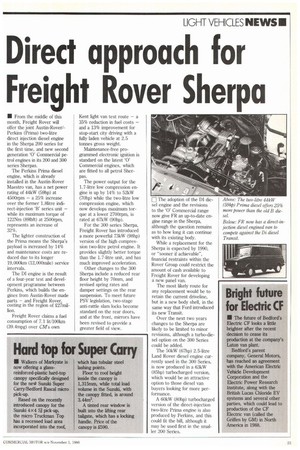Freight Rover Sherpa
Page 25

If you've noticed an error in this article please click here to report it so we can fix it.
• From the middle of this month, Freight Rover will offer the joint Austin-Rover/Perkins (Prima) two-litre direct injection diesel engine in the Sherpa 200 series for the first time, and new second generation '0' Commercial petrol engines in its 200 and 300 series Sherpas.
The Perkins Prima diesel engine, which is already installed in the Austin-Rover Maestro van, has a net power rating of 44kW (59hp) at 4500rpm — a 25% increase over the former 1.8litre indirect-injection `B' series unit — while its maximum torque of 122Nm (89Ibft) at 2500rpm, represents an increase of 32%.
The lighter construction of the Prima means the Sherpa's payload is increased by 14% and maintenance costs are reduced due to its longer 19,000km (12,000mile) service intervals.
The DI engine is the result of a four-year test and development programme between Perkins, which builds the engines from Austin-Rover made parts —and Freight Rover, i costing n the region of ,227mi1lion.
Freight Rover claims a fuel consumption of 7.1 lit/100km (39.4mpg) over 'Ms own Kent light van test route — a 35% reduction in fuel costs — and a 13% improvement for stop-start city driving with a fully laden vehicle at 2.5 tonnes gross weight.
Maintenance-free programmed electronic ignition is standard on the latest '0' Commercial engines, which are fitted to all petrol Sherpas.
The power output for the 1.7-litre low compression engine is up by 14% to 52kW (70hp) while the two-litre low compression engine, which now develops maximum torque at a lower 2700rpm, is rated at 67kW (90hp).
For the 300 series Sherpa, Freight Rover has introduced a more powerful 73kW (98hp) version of the high compression two-litre petrol engine. It provides slightly better torque than the 1.7-litre unit, and has much improved acceleration.
Other changes to the 300 Sherpa include a reduced rear floor height by 70mm, and revised spring rates and damper settings on the rear suspension. To meet future PSV legislation, two-stage anti-rattle slam locks become standard on the rear doors, and at the front, mirrors have been revised to provide a greater field of view.
E The adoption of the DI. diesel engine and the revisions to the '0' Commercial range now give FR an up-to-date engine range in the Sherpa, although the question remains as to how long it can continue with its existing body.
While a replacement for the Sherpa is expected by 1990, or "sooner if achievable", financial restraints within the Rover Group could restrict the amount of cash available to Freight Rover for developing a new panel van.
The most likely route for any replacement would be to retain the current driveline, but in a new body shell, in the same way that Ford introduced its new Transit.
Over the next two years changes to the Sherpa are likely to be limited to minor revisions, although a turbo-diesel option on the 300 Series could be added.
The 50kW (6'7hp) 2.5-litre Land Rover diesel engine currently used in the 300 Series, is now produced in a 63kW (85hp) turbocharged version, which would be an attractive option to those diesel van buyers looking for more performance.
A 60kW (80hp) turbocharged version of the direct-injection two-litre Prima engine is also produced by Perkins, and this could fit the bill, although it may be used first in the smaller 200 Series.




















































































